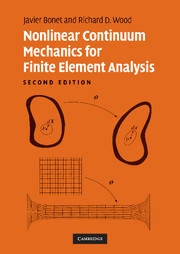Book contents
- Frontmatter
- Contents
- Preface
- 1 INTRODUCTION
- 2 MATHEMATICAL PRELIMINARIES
- 3 ANALYSIS OF THREE-DIMENSIONAL TRUSS STRUCTURES
- 4 KINEMATICS
- 5 STRESS AND EQUILIBRIUM
- 6 HYPERELASTICITY
- 7 LARGE ELASTO-PLASTIC DEFORMATIONS
- 8 LINEARIZED EQUILIBRIUM EQUATIONS
- 9 DISCRETIZATION AND SOLUTION
- 10 COMPUTER IMPLEMENTATION
- Bibliography
- Index
10 - COMPUTER IMPLEMENTATION
Published online by Cambridge University Press: 06 July 2010
- Frontmatter
- Contents
- Preface
- 1 INTRODUCTION
- 2 MATHEMATICAL PRELIMINARIES
- 3 ANALYSIS OF THREE-DIMENSIONAL TRUSS STRUCTURES
- 4 KINEMATICS
- 5 STRESS AND EQUILIBRIUM
- 6 HYPERELASTICITY
- 7 LARGE ELASTO-PLASTIC DEFORMATIONS
- 8 LINEARIZED EQUILIBRIUM EQUATIONS
- 9 DISCRETIZATION AND SOLUTION
- 10 COMPUTER IMPLEMENTATION
- Bibliography
- Index
Summary
INTRODUCTION
We have seen in the previous chapters that the solution to the nonlinear equilibrium equations is basically achieved using the Newton–Raphson iterative method. In addition, in a finite element context it is advisable to apply the external forces in a series of increments. This has the advantage of enhancing the converging properties of the solution and, where appropriate, provides possible intermediate equilibrium states. Moreover, for path dependent materials such as those exhibiting plasticity, these intermediate states represent the loading path which needs to be accurately followed. Furthermore, it is clear that the two fundamental quantities that facilitate the Newton–Raphson solution are the evaluation of the residual force and the tangent matrix. In this chapter we shall describe the FORTRAN implementation of the solution procedure in the teaching program FLagSHyP, (Finite element Large Strain Hyperelasto-plastic Program).
It is expected that the reader already has some familiarity with the computer implementation of the finite element method in the linear context. Consequently, this chapter will emphasize those aspects of the implementation that are of particular relevance in the nonlinear finite deformation context. In this respect, it is essential to understand two crucial routines. Firstly, the master routine that controls the overall organization of the program and, secondly, the subroutine elemtk. This latter routine computes the equivalent nodal forces due to internal stress and the main components of the tangent stiffness matrix. Consequently, it provides a vehicle for examining those aspects of the computation that are particular to finite deformation analysis.
- Type
- Chapter
- Information
- Nonlinear Continuum Mechanics for Finite Element Analysis , pp. 266 - 311Publisher: Cambridge University PressPrint publication year: 2008



